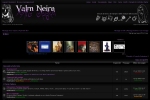Inizio ad anticiparvi il fatto che le pagine Wiki vanno formattate un minimo.

Per venire incontro a chi non conosce HTML c'è un sistema semplificato di sviluppo delle pagine.

E' facilmente consultabile durante la scrittura dei vostri articoli, ve lo anticipo qui per sicurezza (e così magari ne discutiamo).
Enfasi: '' per corsivo, __ per neretto, ''__ per entrambi
Elenchi: * per elenchi puntati, # per elenchi numerati, ;term:definizione per elenchi di definizioni
Riferimenti Wiki: UnisciParoleInMaiuscolo o usa ((pagina)) o ((pagina|disc)) per riferimento sul wiki, ))QualcheNome(( impedisci riferimenti
Disegni: {draw name=foo} Crea il disegno foo
Link esterni: use square brackets for an external link: [URL] or [URL|link_description] or [URL|description|nocache] (that last form prevents the local Wiki from caching the page; please use that form for large pages!).
For an external Wiki, use ExternalWikiName:PageName or ((External Wiki
Name: Page Name))
Multi-page pages: use ...page... to separate pages
Headings: "!", "!!", "!!!" crea titoli
Show/Hide: "!+", "!!-" show/hide heading section. + (shown) or - (hidden) by default.
Misc: "----" crea una linea orizzontale "===testo===" sottolinea testo.
Barra del titolo: "-=titolo=-" crea una barra titolo.
Wiki File Attachments: {file name=file.ext desc="description text" page="wiki page name" showdesc=1} Creates a link to the named file. If page is not given, the file must be attached to the current page. If desc is not given, the file name is used for the link text, unless showdesc is used, which makes the file description be used for the link text. If image=1 is given, the attachment is treated as an image and is displayed directly on the page; no link is generated.
Immagini: "{img src=http://example.com/foo.jpg width=200 height=100 align=center imalign=right link=http://www.yahoo.com desc=foo alt=txt usemap=name}" mostra una immagine height, width, desc, link and align sono opzionali
Immagini non cacheabili: "{img src=http://example.com/foo.jpg?nocache=1 width=200 height=100 align=center link=http://www.yahoo.com desc=foo}" mostra una immagine height, width, desc, link and align sono opzionali
Tabella: "||row1-col1|row1-col2|row1-col3||row2-col1|row2-col2col3||" crea una tabella
Sorgenti RSS: "{rss id=n max=m}" mostra la sorgente rss con id=n e massimo=m elementi
Riquadro singolo: "^Contenuto del riquadro^" Crea un riquadro con i dati
Contenuto dinamico: "{content id=n}" Verrà rimpiazzato con il contenuto corrente del blocco dinamico con id=n
Testo colorato: "~~#FFEE33:qualche testo~~" Apparirà usando il colore HTML indicato
Centra: "::qualche testo::" Mostrerà il testo centrato
Sezioni non interpretate: "~np~ data ~/np~" Prevents wiki parsing of the enclosed data.
Preformated sections: "~pp~ data ~/pp~" Displays preformated text/code; no Wiki processing is done inside these sections (as with np), and the spacing is fixed (no word wrapping is done).
Square Brackets: Use [[foo] to show [foo].
Block Preformatting: Indent text with any number of spaces to turn it into a monospaced block that still follows other Wiki formatting instructions. It will be indended with the same number of spaces that you used. Note that this mode does not preserve exact spacing and line breaks; use ~pp~...~/pp~ for that.
Dynamic variables: "%nome%" Inserts an editable variable
Insert Module Output: {MODULE(module=>some_module)}text{MODULE} can be used to insert the output of module "some_module" into your Wiki page. See PluginModule for more information.
Rendering Program Code: {CODE()}some code{CODE} will render "some code" as program code. This plugin has other options; see PluginCode.
Direction: "{r2l}", "{l2r}", "{rm}", "{lm}" Insert resp. right-to-left and left-to-right text direction DIV (up to end of text) and markers for langages as arabic or hebrew.
Table of contents "{toc}", "{maketoc}" prints out a table of contents for the current page based on structures (toc) or ! headings (maketoc)
Line break: "%%%" (very useful especially in tables)
Misc: "{cookie}, {poll}"
